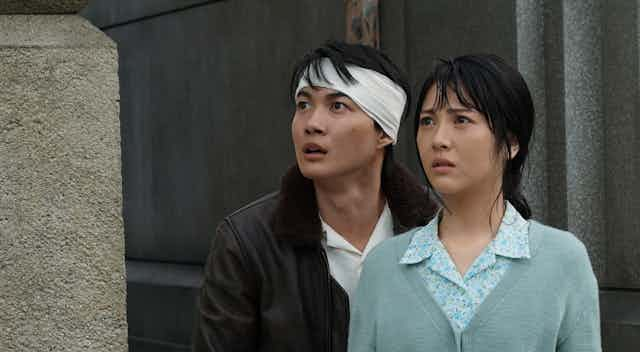Godzilla Minus One, directed by Takashi Yamazaki, brings viewers back to post-war Japan and to the wholly belligerent monster of the original 1954 Godzilla — a beast bereft of the friendly connotations accrued in the later Toho Studios Japanese installments.
This original Godzilla represented what its director, Ishiro Honda, described as the “invisible fear” of the nuclear contamination of our planet.
Historian William Tsutsui asserts in his book dedicated to the series that the film allows us to neutralize our fears of potential annihilation. Cathartic or not, this apocalyptic trend remains a staple of science-fiction movies and series to this day.
Minus One returns to that fear, once perhaps invisible but now undeniable, of the disasters incurred by damage to our environment.
At the same time, the film asks how individuals and communities can tackle disaster while embracing an ethos of mutual aid that sidesteps nostalgia for nationalist policies that lead to even more harm.
Disaster response
In the two most recent instalments in the Godzilla franchise, 2016’s Shin Godzilla and 2023’s Godzilla Minus One, the monster can be read as a personification of a diminished belief in governmental abilities to prevent or respond adequately to disaster.
Shin Godzilla, directed by Hideaki Anno, dealt satirically with the limp governmental response to the 2011 Tohoku Earthquake and Tsunami. As the threat of the monster escalates to catastrophic levels, the politicians in the film are more concerned with optics and in which board room they should be conducting their meetings.
In contrast, 2023’s Minus One captures ire for a nationalistic government that guided Japan into imperial campaigns in Asia and finally to a total defeat with a devastating human cost.
When Godzilla arrives to further compound post-war misery, harried survivors don’t rely on the same government that has led them astray.
Putting aside ideological differences
Instead, as some reviews of the film have noted, they turn to a community with the power to act outside of official bodies, making use of technological skills earned through wartime experience.
While the state lends them a few ships, citizens are otherwise left to their own devices, relying on old and decommissioned machinery. They rise to face the monster not by developing a new weapon of destruction but by using what is already at hand.

The characters in Minus One create a shared purpose in light of their wartime experience. As engineer Noda notes, their lives have been undervalued. This realization leads them to turn away from the government and the nationalist policies that led to the war, and to rely instead on one another.
To do this they must put aside ideological differences to achieve the common goal of stopping Godzilla. This is best illustrated by the co-operation of Koichi Shikishima, a kamikaze pilot who questions the value of his death amid imminent defeat yet is dogged by the shame of his desertion, and an engineer, Sosaku Tachibana, who initially deems Shikishima a coward.
Revisiting values, alliances
These plotlines reflect contemporary interest in the local and political communities we should be forging in light of serious environmental threats.
Read more: Ecological grief and uncontrollable reality in Wes Anderson's 'Asteroid City'
Writer Rebecca Solnit laments self-serving governmental responses to disaster. But her A Paradise Built in Hell focuses on the positives that can come from disaster at the communal level.
She concludes that in enhancing social cohesion and bringing out the humanitarian in each of us, disaster “reveals what else the world could be like.” In short, a paradise of shared purpose and co-operation.
The key, however, is distinguishing between a benign social cohesion, like the aforementioned networks of mutual care, and a malignant one, as seen in destructive forms of nationalism and war.

In Godzilla Minus One, Shikishima and Tachibana band together to save lives. Their wider group insists on a victory without the sacrifice of human life, an ethos made possible by adopting a communal view in which humans are not statistics.
Dream together or die alone
At a time of an increasingly nationalist Japanese government that has been criticized for undermining freedom of the press, the film suggests how a nostalgic dream for a return to a time of stronger social ties and a sense of unified purpose is one easily manipulated by nationalist governments.
This has been seen in a host of recent examples including Donald Trump, Brexit and, as mentioned above, the policies of Shinzo Abe’s Liberal Democratic Party.
On the global scale, the rise of populism, diplomatic spats and outright conflict sees much of the world drawing away from their neighbours. This is happening when, to counteract the effects of climate change and face the exponential increase in disaster, we must unite.
Godzilla Minus One shows how we must rely on a fondness — even a nostalgia — for times of togetherness that do not mix with a nationalist sentiment that encourages isolationism and aggression towards others.
To do so really would be to go from zero to minus one. From there, there is little guarantee we can recover.

